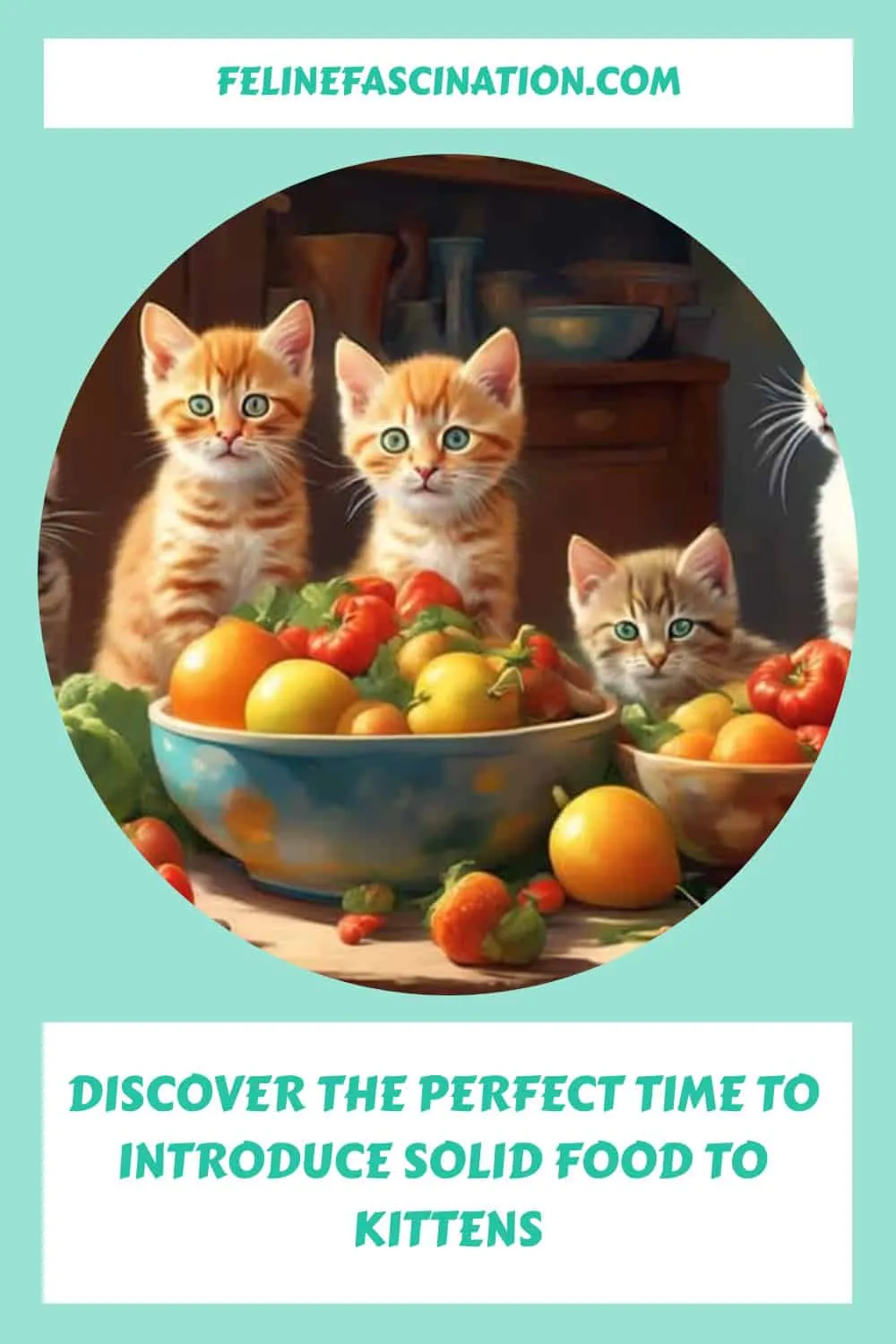The Best Fluffy Pancakes recipe you will fall in love with. Full of tips and tricks to help you make the best pancakes.

Are you a new kitten owner, eagerly awaiting the moment when you can introduce solid food to your furry companion? Well, get ready because we're about to uncover the perfect time for this significant milestone.
But why is timing so crucial? And how can you ensure a successful transition? These questions will be answered as we explore the recommended age for weaning kittens, the benefits of a gradual introduction, and the signs that indicate your little bundle of fur is ready for solid food.
So, let's embark on this informative journey together, and discover the secrets to introducing solid food to your adorable kitten.
Key Takeaways
- Weaning should begin when kittens are around 4 to 6 weeks old to help them develop their teeth, jaw muscles, and digestive system.
- It is recommended to wait until 12 weeks before sending kittens to new homes to ensure they have enough time with their mother and are properly weaned.
- Wet food is recommended for weaning kittens as it is easier for them to chew and digest, and should be gradually introduced alongside kitten formula.
- Kittens should have a free-choice eating routine with small amounts of food available all the time, and their food intake and weight should be monitored regularly.
Importance of Weaning Kittens
Introducing solid food to kittens through the weaning process is of utmost importance for their overall growth and development. Proper kitten nutrition during this stage sets the foundation for their lifelong health.
The weaning process involves gradually transitioning kittens from their mother's milk to solid food, allowing them to develop their teeth, jaw muscles, and digestive system. It's crucial to start this process when the kittens are around 4 to 6 weeks old. Delaying the introduction of solid food can hinder their growth and development. By consulting a veterinarian, you can determine the appropriate time to start weaning and ensure that the kittens receive the necessary nutrients.
Each kitten may have different readiness for solid food, so it's essential to observe their behavior and adjust accordingly. Providing high-quality kitten food that's specifically formulated to meet their nutritional needs is crucial. Wet food is recommended for weaning kittens as it's easier for them to chew and digest. Gradually introduce a variety of textures and flavors to expand their palate. It's important to offer fresh water alongside their food to keep them hydrated.
By following the right feeding techniques, such as mixing wet food with kitten formula and gradually decreasing the formula quantity, you can ease their transition to solid food. Place the food in a shallow dish near the kittens, as mother cats can show them how to eat from the dish. It's important to monitor their eating habits and adjust the feeding schedule accordingly. Avoid force-feeding or overwhelming them with large amounts of food. Establish a consistent feeding schedule to promote healthy eating habits.
Optimal Age for Introducing Solid Food
The optimal age for introducing solid food to kittens is around 4 to 6 weeks old, as this is when they start to develop the necessary teeth, jaw muscles, and digestive system for consuming solid food. This is an important milestone in their growth and development.
It's crucial to follow the best weaning practices during this period to ensure a smooth transition from mother's milk to solid food. However, there can be potential challenges in the weaning process, such as kittens being hesitant to try new foods or experiencing digestive issues. By observing their behavior and adjusting accordingly, you can help them overcome these challenges.
It's always recommended to consult a veterinarian to determine the appropriate time for introducing solid food and to address any concerns or questions you may have.
Benefits of Gradual Weaning Process
To ensure a smooth and successful introduction of solid food to your kittens, it's important to gradually wean them from their mother's milk, taking into consideration their individual readiness and developmental needs. Here are the benefits of a gradual weaning process:
- Promotes healthy growth and development: Early weaning allows kittens to receive the necessary nutrients from solid food, supporting their overall growth and development.
- Encourages independence: Gradual weaning helps kittens become more independent and self-sufficient as they learn to eat on their own.
- Prevents nutritional deficiencies: Delaying the introduction of solid food can lead to nutritional deficiencies, as kittens may not receive the essential nutrients they need for optimal health.
- Minimizes stress and anxiety: A gradual weaning process helps kittens adjust to the transition from milk to solid food, reducing stress and anxiety.
- Establishes healthy eating habits: By introducing solid food gradually, kittens can develop healthy eating habits, ensuring they maintain a well-balanced diet throughout their lives.
Extended Stay With Mother Cat
During the weaning process, it's highly recommended to allow kittens to stay with their mother for at least a month after starting solid food. This extended stay with their mother provides several benefits for the kittens.
Firstly, it helps them continue to receive important nutrients and antibodies from their mother's milk, boosting their immune system and overall health.
Secondly, the mother cat plays a crucial role in teaching her kittens important social and behavioral skills, such as grooming, using the litter box, and interacting with other cats.
This extended stay also helps reduce the chances of behavioral changes and separation anxiety in kittens, as they gradually transition to independent eating and living.
Evolution of Recommended Adoption Age
The recommended age for adopting kittens has evolved over time, taking into consideration their developmental needs and overall well-being.
- Previously, kittens were sent to new homes at 6 to 8 weeks of age.
- Now, it's recommended to wait until 12 weeks before adopting a kitten.
This evolution in adoption age has been influenced by research on kitten development. Waiting until 12 weeks ensures that kittens have enough time with their mother and littermates to learn important social and behavioral skills. It also allows them to fully develop physically, including their immune system and digestive system.
The impact of this evolution of adoption age on kitten development is significant. By waiting until 12 weeks, kittens have a better chance of growing into healthy and well-adjusted cats. They have the opportunity to learn important behaviors from their mother and siblings, which helps them navigate the world and develop proper social skills. Additionally, their immune system and digestive system have more time to mature, reducing the risk of health issues later in life.
Developmental Milestones Supported by Weaning
As we explore the developmental milestones supported by weaning, it's important to understand how the introduction of solid food at the appropriate age contributes to the overall growth and well-being of kittens.
Weaning is a crucial stage where kittens transition from a diet solely consisting of their mother's milk to consuming solid food. By introducing solid food, kittens develop important developmental milestones such as the growth of their teeth, jaw muscles, and digestive system.
It's during this time that their nutritional requirements change, and they begin to rely less on their mother's milk for sustenance. Providing a balanced and nutritious diet during weaning ensures that kittens receive the necessary nutrients to support their growth and development.
Therefore, it's essential to carefully monitor their dietary needs and consult a veterinarian for guidance on meeting their specific nutritional requirements.
Signs of Readiness for Solid Food
When determining if your kitten is ready for solid food, there are several signs you can look for to ensure a smooth transition.
- Increased interest in your food: If your kitten starts showing curiosity about what you're eating and tries to snatch some, it may be a sign that they're ready to explore new tastes and textures.
- Chewing behavior: Kittens who are ready for solid food may start chewing on objects around them, such as toys or their littermates. This indicates a growing need to exercise their jaw muscles and develop their teeth.
- Signs of hunger: If your kitten seems unsatisfied with just milk and starts demanding more frequent feedings, it may be a sign that they're ready for solid food. Look for increased meowing or vocalization during feeding times.
- Ability to lap liquids: Before introducing solid food, kittens should demonstrate the ability to lap liquids, such as water or milk, from a shallow dish. This shows that their tongue and mouth coordination is developing.
- Curiosity about the food dish: When your kitten starts investigating the food dish and shows interest in its contents, it indicates a readiness for solid food. They may even try to dip their paws in the dish or sniff the food.
Observing these signs will help you determine when your kitten is ready for the exciting journey of introducing new textures and flavors into their diet.
Consulting a Veterinarian for Guidance
If you have observed the signs of readiness for solid food in your kitten, it's crucial to consult a veterinarian for expert guidance and advice on introducing solid food. A veterinarian can provide vet recommendations specific to your kitten's age, health, and individual needs. They can assess your kitten's overall health and determine the appropriate time to start introducing solid food.
Additionally, a veterinarian can address any potential challenges you may encounter during the weaning process, such as difficulty transitioning from formula to solid food, or any concerns regarding allergies or digestive issues. Seeking professional guidance from a veterinarian ensures that you're providing the best care and nutrition for your kitten's optimal growth and development.
Selecting the Right Food for Weaning
To ensure a smooth weaning process for your kitten, it's crucial to carefully select the right food that meets their nutritional needs and supports their growth and development. When choosing the appropriate food for weaning, consider the following:
- Opt for wet food: Wet food is recommended for weaning kittens as it's easier for them to chew and digest.
- Look for high-quality kitten food: Choose a high-quality kitten food that's specifically formulated to meet their nutritional needs.
- Introduce a variety of textures: Gradually introduce different textures to expand their palate and help them adjust to solid food.
- Explore new flavors: Introduce new flavors to keep their meals interesting and encourage a well-rounded diet.
- Provide fresh water: Make sure to provide fresh water alongside their food to keep them hydrated.
Feeding Techniques for Successful Weaning
Start by introducing wet food mixed with kitten formula and gradually decreasing the quantity of formula. This feeding technique for successful weaning ensures a smooth transition from a liquid to solid diet.
Place the food in a shallow dish near the kittens, allowing the mother cat to demonstrate eating from the dish. At around 4 to 6 weeks, moistened kibbles can be introduced, followed by dry food at 6 weeks.
Initially, offer small amounts of wet food on a shallow plate or saucer, allowing the kittens to explore and lick the food at their own pace. As they become more comfortable with eating, gradually increase the portion size.
It's important to monitor their food intake and adjust the feeding schedule accordingly. Avoid force-feeding or overwhelming them with large amounts of food.
Conclusion
In conclusion, weaning kittens is a crucial process that should be approached with care and patience. By following the recommended age for introducing solid food and gradually transitioning, you can ensure healthy growth and development for your furry friend.
Remember to consult a veterinarian for guidance and select the right food for weaning. With the right techniques and schedule, you'll navigate this phase successfully and create a strong bond with your adorable little companion.
Don't miss out on this purrfect opportunity to give your kitten the best start in life!










